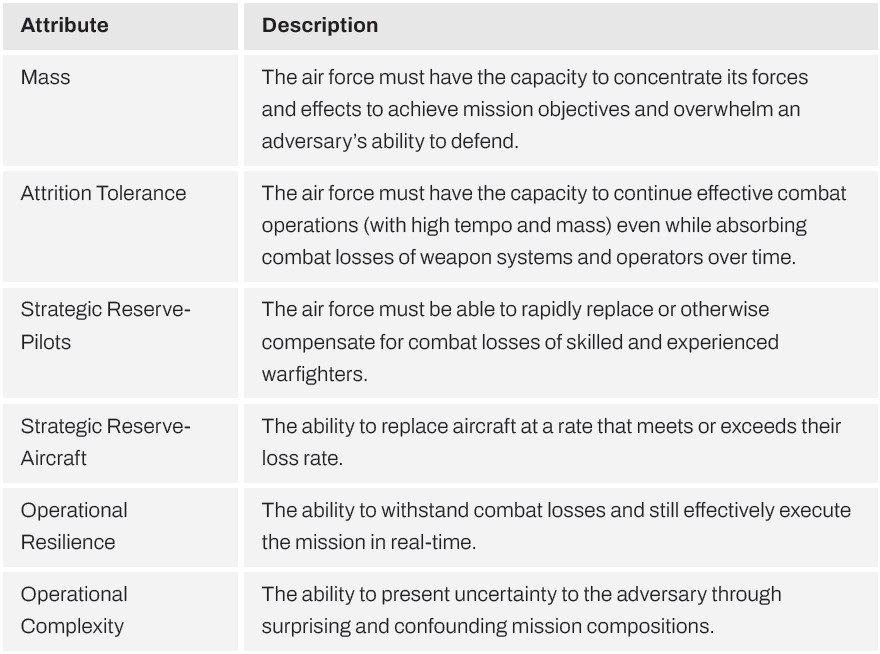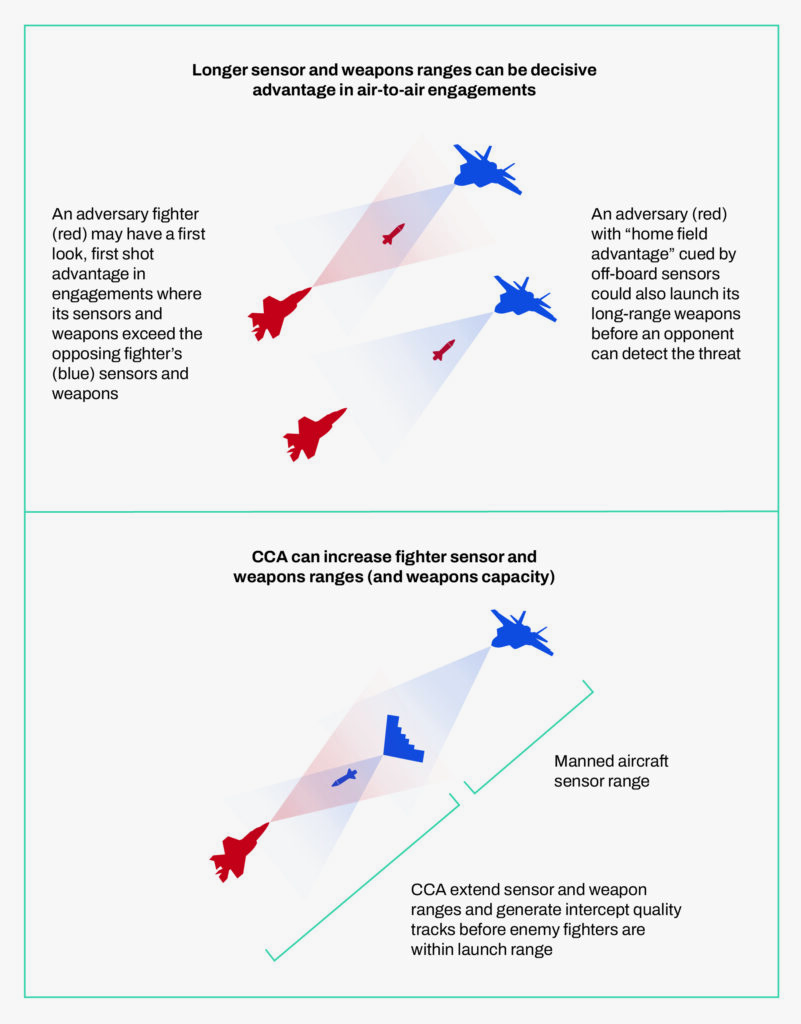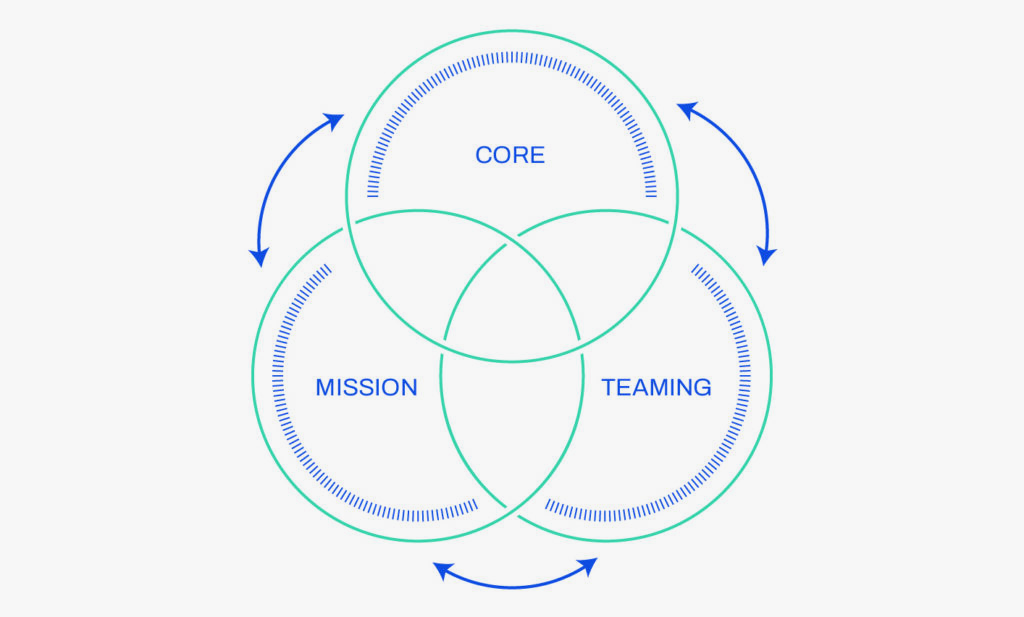Introduction
A family of collaborative combat aircraft (CCA) fielded at scale could increase the combat capacity of an air force, create a more attrition-tolerant/resilient force mix, provide commanders with a strategic reserve for surge operations, and enable complex operations that complicate an adversary’s defenses. While this approach has great potential, current CCA development efforts primarily focus on mission tasks. (Department of the Air Force Scientific Advisory Board, 2022) This is problematic because the effectiveness of CCA in combat will be primarily driven by how well they team with humans, not just capabilities such as weapons and sensors. From the start, highly experienced warfighters must be integrated with skilled technologists to structure teaming dynamics, using human flying formations as models. Because teaming dynamics will interact with all other CCA autonomy software, teaming must be built in from the very beginning. Figure 1 highlights the key attributes needed by air forces in future peer-on-peer conflict that CCA can provide.

Human-Machine Teaming
For the purposes of this assessment, CCA are semi-autonomous uncrewed combat aircraft that are equipped with a mix of sensors, weapons and other equipment that can be tailored to perform different missions. This means that CCA autonomy will need to be a mix of traditional, deterministic software and machine learning algorithms and will still require human interaction for the aircraft to execute their mission. To date, research and development efforts have primarily focused on the most obvious problem of how to remove humans from CCA logic and control systems. (Interview, 2022).
Without question, engineers are making progress on important, foundational challenges related to CCA development, like autonomous flight control dynamics, flight safety, battlespace awareness, tactical decision-making, and sensing and maneuvering. However, developing an understanding of how CCA will team with humans is largely missing from current efforts. What is lagging, or even absent, is warfighter involvement in the process to determine how CCA should interact with humans and what information humans need for those interactions to be effective in real-world operations. Warfighters must be involved in the early stages of CCA development programs to shape how these autonomous aircraft will operate alongside humans in the battlespace.
This approach is not new—the need to understand and account for how humans interact with machines and vice versa is now called “human factors engineering,” which is a human-centered approach to the science of designing how humans interact with machines to enhance the performance of human-machine teams. For example, early cockpit designs did not account for the limitations of human perception, task loading, habits, cognition, and other behavior. Aircraft instrumentation and controls were often optimized for available space and weight in the confined spaces of a cockpit, not pilot performance. This contributed to aircraft incidents and accidents. As aircraft became more complex, human factors engineering became a critical part of designing aircraft. Today’s fifth-generation aircraft, like the F-35 stealth fighter, demonstrate how human factors engineering and advanced processing technologies can streamline task loads and enable pilots to do what humans do best: perform high-order cognitive tasks like decision-making and battle management. Collaborative combat aircraft are meant to team with a human warfighter, yet, for the most part, warfighters are being left out of CCA development. Human factors engineering should be deliberately prioritized as a first principle for developing CCA.
The following concepts are key to the development of CCA that provide meaningful contributions not just in the battlespace, but to the warfighter.
Collaborative combat aircraft are meant to team with a human warfighter, yet, for the most part, warfighters are being left out of CCA development. Human factors engineering should be deliberately prioritized as a first principle for developing CCA.
Heather R. Penny
Identify the Relative Strengths and Weaknesses of Humans and Collaborative Combat Aircraft to Build the Right Human-CCA Team
As CCA mission packages and operational concepts solidify, consider the existing mission gaps of modern air forces and how CCA could fill these gaps. Specifically, how can CCA create complex system of systems that enhance resiliency in the battlespace while posing dilemmas to the adversary? Deliberately constructing teams to leverage the strengths of humans and machines can maximize their relative operational value and mitigate their respective vulnerabilities.
Develop Operational Concepts, Concepts of Employment, and Tactics, Techniques, and Procedures to Exploit Team Strengths
Although warfighters generally agree that autonomous CCA teammates could provide operational advantages in a peer conflict, many continue to question the nuts and bolts of what CCA should do in contested battlespaces. For example, how could human-CCA team attributes help counter adversary threats, to include their decision-making processes as well as their systems? How could CCA-hosted AI/ML identify an adversary’s behavior patterns in the battlespace to increase threat or target awareness, and how could they rapidly propose alternate flight paths to increase team survivability? Can swarms of CCA frustrate an adversary’s targeting, obfuscate the locations of friendly aircraft, or conceal friendly mission objectives? How could CCA be employed in ways that extend and slow an adversary’s decision processes, keeping them in a “paralysis of analysis” instead of acting? Once policymakers and warfighters understand the respective attributes of human-CCA teams, they can begin to answer these questions and map how CCA should operate, maneuver, and partner with humans to achieve mission success. Figure 2 illustrates one such concept.

Program Teaming Dynamics into CCA, Modeled on Proven Human-Human Combat Team Interactions
Human factors in teaming dynamics and protocols must take greater precedence in the development of CCA designs and software. Technologists must treat teaming as more than human inputs to the CCA, the technical information humans and machines share, and the datalinks they use. True collaborative teaming operations include behaviors like the give-and-take of roles and responsibilities across teammates as well as standard procedures, contracts, and formations. This will require technologists to account for human cognition, emotions, feedback loops, communication, trust, errors, and the many other interpersonal pieces of team dynamics as they develop CCA software and algorithms. An effective way of doing this is to use insights from warfighters to inform CCA software and algorithm development and maturation.
Build Mastery Through Continual Test and Training
Warfighters will need robust simulations and real-world flights to master CCA teaming concepts and tactics and develop confidence that CCA will provide a combat edge in highly contested battlespaces. While much of this can be done in simulation, warfighters need exposure and experience with CCA teammates in the real, physical world to build familiarity, trust, and then master teaming operations. CCA must fly training sorties with average line pilots of varying skill levels and experience to prove their combat effectiveness, not just a small cadre of highly trained members of the operational test and evaluation community. If CCA are only effective in tightly controlled, perfect environments, they may not be reliable in combat. Warfighters of varying experience and abilities also must have the opportunity to mission plan, fly, and debrief with CCA on a regular basis, both to train the humans and to train the CCA. Because CCA will be part of future combat mission packages, flight training must be more frequent than the sporadic missile tests or live weapon drops that aircrews currently perform as part of their training.
Involve Warfighters in CCA Development to Enhance Their Understanding of the CCA Agent
Warfighters should participate in shaping the logic, interaction, incentives, weights, and models of CCA autonomy so that CCA behavior in real-world operations makes sense to them. This means that engineers and technologists must collaborate with current and qualified operators to ensure that CCA autonomy is aligned with warfighter needs. CCA machine learning algorithms optimize very specific outcomes such as their fuel burn rates, threat avoidance maneuvers, airspeed to targets, and so forth. These algorithms are layered with others and then embedded within traditional deterministic software to produce specific behaviors. Involving warfighters deeply in CCA development would improve their understanding of how CCA algorithms and programming layers interact to create CCA decision behaviors.
Operators should be involved in the CCA developmental process—ideally by embedding them in CCA development teams—not only to ensure their autonomous teammates perform actions as expected but so they also understand and can explain the logic that underpins their behavior. Similarly, humans must be able to trust that CCA will not execute dangerous actions that seem like logical solutions for the CCA agent. While these requirements may seem obvious, developing software with the necessary attributes will require robust simulation and actual flights that incrementally test and then adjust their performance in increasingly difficult situations.
Operators should be involved in the CCA developmental process—ideally by embedding them in CCA development teams—not only to ensure their autonomous teammates perform actions as expected but so they also understand and can explain the logic that underpins their behavior.
Heather R. Penny
Develop Interactive Mission Tools to Support Continual Learning and Mastery
Humans will need robust mission planning tools to integrate their CCA into their operational plans. While many teaming tactics and roles will be standardized, humans will need to be able to adjust and customize CCA decision processes and behaviors to accommodate the specifics of a particular mission’s objective, threat order of battle, intelligence reports, risk levels, and commander intent. They must also be able to identify contingency plans, to include what many warfighters call “audibles”—deviations from the plan that are communicated in real-time. Moreover, as humans learn more about the unique attributes of CCA, there may be other elements that they seek to adjust for the mission. All of these are important elements of mission planning.
Develop Processes to Assure Algorithm Integrity and Data Security
Establishing trust in the levels of autonomy and machine learning in CCA will require giving warfighters the means to continuously monitor the health of the CCA agent and the veracity of its sensor data and other inputs. Warfighters must also trust that the integrity of their CCA agent’s software and AI/ML has not been corrupted or maliciously hacked by an adversary. This will require processes to detect and reject malign attempts to attack, degrade, or control CCA. Given the evolutionary nature of AI/ML, developing and sustaining this degree of assurance and security must be part of everyday CCA operations. It cannot stop with CCA development. The nature of machine learning programs is to change and adapt with every data input and run repetition. These data-driven adaptations may yield improved mission performance, but changes in CCA behavior that are not transparent and understood may also obscure corrupted data or malicious attacks.
CCA Must Share the Same Battlespace Awareness as their Humans
For humans and CCA to effectively synchronize their efforts as a team and as part of a larger mission package, they must share the same understanding of the battlespace. This requires each element of a team to continuously update each other to improve the whole team’s situational awareness. Maneuvering, coordinated action, tactical priorities, targeting, and other decisions and behaviors are all contextual—if a CCA agent does not have the same battlespace picture, it will not behave in the ways that humans need or expect. The need for shared battlespace awareness is further complicated by the limitations of autonomy. When AI/ML algorithms are presented with environments that do not fit into previous training experiences, their behavior may be unpredictable or even dangerous. Divergent CCA behavior may counter human actions in the battlespace, confuse or complicate other elements of the mission package, or even fail to act at all. Humans must use their applied understanding of how their CCA agent will respond to battlespace stimuli and other inputs so they may anticipate, preempt, and manage CCA behavior in unanticipated or untrained scenarios. This is critical to flight safety, the integrity of teamed operations, and mission success.
Understanding the Difference Between Directive and Descriptive Control
When the level of CCA control is not automatically mandated by a procedure or normalized by standards, human teammates will need to choose between using directive or descriptive control actions. Directive control is often used in low-trust teaming relationships to “fix” CCA teammate errors or continue operations when a teammate is determined to be not fully competent. Fighter flight leads often use directive control with new wingmen because they lack the experience and skill to accurately perceive the battlespace, make good teaming decisions, and then maneuver effectively. At the other end of the control scale, humans use descriptive control when they have high trust in their teammates or are task saturated. In a high-trust teaming scenario, humans use descriptive control because they believe the teammate shares their battlespace awareness and will act appropriately. A benefit of descriptive control is that it provides the greatest independence in action and could enable innovative CCA behaviors while decreasing human workloads.
To facilitate effective teaming operations, humans must be able to dynamically adjust their level of CCA control based on real-time battlespace demands. This means humans should be able to fluidly shift between directive and descriptive control as needed over the course of a mission. This adaptability is important to optimize human workloads, exploit the unique attributes of CCA, and respond to changing battlespace conditions. See Figure 3 for a framework explaining the ways in which CCA autonomy can be dialed up or down.
CCA Must Proactively and Responsively Communicate with Humans to Assure Control
Humans often provide a verbal acknowledgment to their flight leads or other mission authorities to indicate that they have received a command and provide affirmation that they will comply. But assured control does not mean that CCA simply acknowledge and blindly execute human directives. True teaming involves a proactive and responsive communication cycle. For example, an experienced wingman might have information that changes a tactic or gameplan, and they may suggest a course of action to the flight lead or even direct the flight to act—which the lead can always override. Alternately, a wingman might respond to a flight lead directive with a “negative” or “unable,” rejecting the direction and immediately following with a brief explanation for why. Communication that assures control includes exchanges that improves the teams’ collective battlespace awareness, suggests courses of action, closes information requests, requests permissions, and acknowledges commands, among others. Warfighters must work with technologists regarding the kinds of information they need from their teammates to assure human control and the best means to display and convey those exchanges.

Prioritize Resilient Connectivity for Teaming Efforts and Develop “Comm-Out” Contingency Plan
CCA control and teaming operations are heavily reliant on networks that connect all aircraft in a team. Without the ability to communicate, humans will struggle to control their autonomous teammates. This problem is little different than what modern human teams face. Connectivity is becoming the foundation of modern battlespace operations as warfighting moves toward disaggregated capabilities, detached formations, systems that provide beyond-visual-range support to each other in contested areas, kill webs, and other networked functionalities. Effective control can become especially challenging when combat situations are unexpected or confusing, as this can easily task-saturate humans and confound their CCA. To facilitate assured control, CCA must provide both proactive communication and responsive feedback to their human. CCA must continue to effectively team with their humans in ways that are aligned with mission objectives, even in worst-case contingencies where communications or datalinks are denied or break down.
Technologists Must Collaborate with Warfighters to Develop Intuitive User Interfaces
Technologists will need to work with warfighters to decompose teaming operations and then leverage existing symbology, “switchology,” and habit patterns to create intuitive user interfaces. Teaming interactions must be thought through the entire mission execution cycle, from engine start to engine shutdown. Engineers must decompose teaming interactions across the span of missions into collaboration tasks with warfighters, since only warfighters can provide the requisite fidelity on mission workflows. Elements of these teaming dynamics include how CCA will communicate with their human, how the human will direct or control CCA, the kinds of information they exchange, and how manned aircraft and CCA must maneuver.
Conclusion
Technologists have focused on proving the viability of autonomous aircraft by decomposing missions into discrete tasks and demonstrating the ability of autonomous aircraft to execute those tasks. In this model, humans have been treated as the occasional data input, just like other sensors or datalinks, and not as true partners. Combat-effective teaming is far more complex and densely interactive. Most importantly, teaming must also honor human performance factors and limitations. This means integrating human factors into teaming algorithms and software. Fortunately, existing human formations can serve as established, high-performing models for technologists to emulate as they develop CCA teaming features.
The following recommendations summarize actions that policymakers and technologists should take to create effective human-CCA teams:
Optimize the composition of human-CCA teams.
- Identify the key relative strengths and weaknesses of humans and CCA to build the right human-CCA teams.
- Develop concepts of employment and tactics, techniques, and procedures to exploit these team strengths and mitigate their shortfalls.
- Program teaming dynamics into CCA, modeled on proven human-human combat team interactions.
- Build mastery of CCA teaming through continual test and training.
Include operators in CCA development and provide them the tools they will need to understand how CCA will perform in the battlespace.
- Involve warfighters in developing explainable CCA machine learning-user interfaces.
- Develop interactive mission planning, mission rehearsal, and debriefing tools to support continual learning and mastery of CCA performance and teaming operations.
Ensure warfighters can depend on CCA autonomy.
- Develop processes for warfighters to assess the real-time integrity, performance, and accuracy of CCA operations.
- Ensure these processes provide warfighters with feedback on CCA algorithm integrity and data security.
- Ensure CCA performance accounts for flight safety and is based on the same battlespace awareness as teamed humans. Human teammates should be able to monitor and assess this collective battlespace awareness to identify situations where actions are needed to compensate when CCA encounter situations they are not trained for.
Ensure warfighters can maintain assured control over CCA in highly dynamic operations.
- Develop teammates that can flexibly and appropriately shift between different control paradigms over the course of a mission.
- Ensure that CCA proactively and responsively communicate with humans to assure control.
- Prioritize resilient connectivity as a technical priority for teaming efforts and develop “comm-out” contracts for CCA.
Ensure teaming workloads are manageable for humans.
- Foster collaboration between technologists and warfighters to develop intuitive human interfaces with CCA.
- Fully integrate CCA command and control interfaces into the warfighter’s weapon system operational flight program.
Humans will continue to be the essential qualitative advantage because of their cognitive flexibility, adaptation, intuition, and other ineffable human traits. Yet collaborative combat aircraft have the potential to do far more than simply augment human missions. CCA can become true force multipliers in ways that far exceed the value of quantity—if their teaming operational concepts, software, interfaces, and other capabilities are developed correctly.
References
Department of the Air Force Scientific Advisory Board. (2022) Collaborative Combat Aircraft for Next Generation Air Dominance, p. 1.
Government Autonomy Program Manager. (2022) Interview.
Gunzinger, M., Stutzriem, L., and Sweetman, B. (2024) The need for collaborative combat aircraft for disruptive air warfare. Mitchell Institute for Aerospace Studies. Available from: https://mitchellaerospacepower.org/wp-content/uploads/2024/02/The-Need-For-CCAs-for-Disruptive-Air-Warfare-FULL-FINAL.pdf
Penney, H.R. (2022) Beyond Pixie Dust: A Framework for Understanding and Developing Autonomy in Unmanned Aircraft. The Mitchell Institute for Aerospace Studies. Available from: https://mitchellaerospacepower.org/beyond-pixie-dust-a-framework-for-understanding-and-developing-autonomy-in-unmanned-aircraft/
Penney, H.R. (2022) Five Imperatives for Developing Collaborative Combat Aircraft for Teaming Operations. The Mitchell Institute for Aerospace Studies. Available from: https://mitchellaerospacepower.org/five-imperatives-for-developing-collaborative-combat-aircraft-for-teaming-operations/






